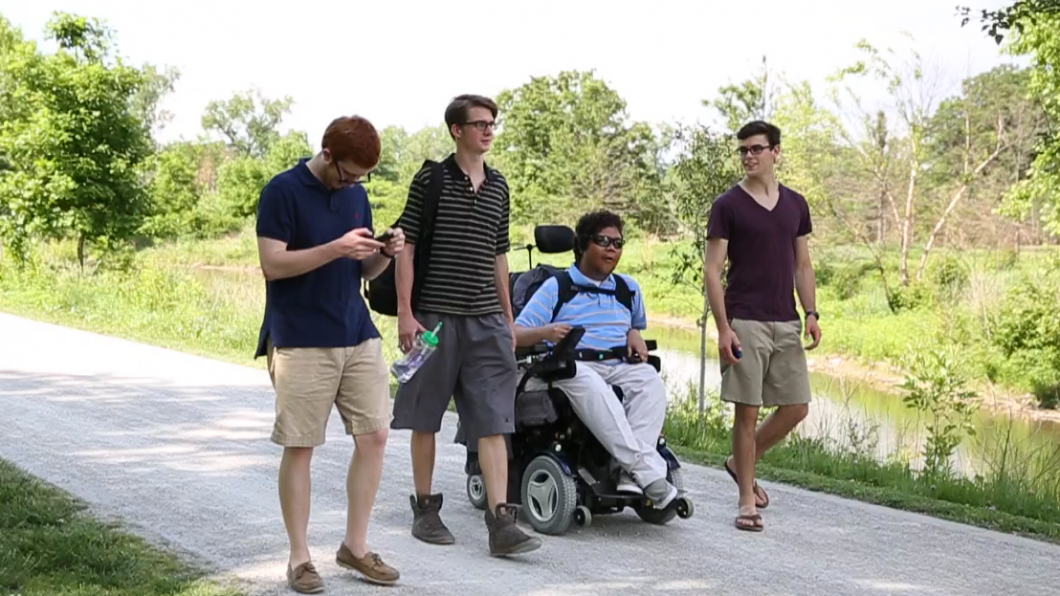
Expecting death, Gabe prepares for life
By Megan Jones
Luke Terrell tells his friend Gabe Weil’s story like this:
By the time he reached his mid-20s, Gabe (above second from right) thought he only had a few more years to live. Diagnosed with Duchenne muscular dystrophy in his childhood, the St. Louis resident had always been told that he could expect to live until the age of 25—if he was lucky. By 10, he needed a wheelchair for mobility. And when he hit his teens, his physical state had deteriorated so drastically he needed help from a full-time caregiver.
Gabe set large, short-term goals. In December of 2013, he graduated with a degree in psychology from Washington University (where he had met Luke two years before). The accomplishment was bittersweet: getting a degree had been a life goal for Gabe. But at 25, he and his family knew the clock was ticking.
Then, at a doctor’s appointment that same month, everything changed. Sitting in a small medical office, Gabe and his mother, Josephine, watched as the doctor examined Gabe’s feet. The doctor mumbled to himself. He paused. He mumbled again. Josephine asked him to repeat himself.
“I said I don’t think Gabe had Duchenne’s,” the doctor explained.
In the months that followed, many doctors performed countless tests to try to determine a new diagnosis. They never settled on one for certain, but something became clear: Gabe Weil was going to live far longer than expected. In fact, his life-expectancy had doubled, doctors said. Suddenly, he needed to plan for a life he never imagined he’d have.
Today, Gabe, 27, is the main character in a documentary that Luke, 23 (above photo, second from left), is directing about his friend. The film, named after its subject, captures Gabe’s transition as he reimagines his life from scratch, and tries to set the long-term goals he never thought he’d need.
***
Luke met Gabe when he began working as his tutor at Washington University in 2011. At the time, both men were completing degrees in psychology. Luke had worked with adults with muscular dystrophy in high school, and teamed up with Gabe on a volunteer basis.
“Initially, I went into the relationship thinking that we wouldn't necessarily have a lot of common ground,” he says.
But that soon changed. One day, after Luke had helped facilitate a test, he asked Gabe how he thought it had gone. “He said, ‘Dude, I don't want to talk about it. Let’s take a shot,’” Luke says.
That broke the ice.
“I didn’t even think he drank,” Luke says. “But all of a sudden he became real and relatable to me,” Luke says. “I realized he had interests, passions, hobbies and dreams just like me and all my friends did.” It was small, surprising moments like these that made Luke want to share Gabe’s story through film.
As their friendship grew, Luke noticed many only considered Gabe at a surface level. They saw him as the “disabled guy” who they couldn't relate to. With the documentary, the director hoped to break some of those stereotypes about young adults with disabilities.
“There’s this tendency to see people with obvious physical disabilities and immediately dehumanize them. I’ve seen people talk to Gabe in a baby voice,” Luke says.
But Luke knew him as someone multi-faceted: Gabe was a foodie who loved going to concerts and listening to new bands. “I wanted to show the impact Gabe had had on me. I wanted to show that he is a bright young man.”
So far, they’ve been working on the film for a year. Prior to beginning the documentary, Luke had directed and produced a number of shorts. But this is his first foray into feature film making.
It hasn’t been without its challenges. Gabe’s muscular dystrophy causes him to speak slower and less clearly than most. Occasionally he needs to take breaks to use a breathing machine. Obstacles like these have slowed the filming process at times.
But they’ve also added to the film. Luke explains that since Gabe has to rely on others to do most daily tasks for him, he’s used to having to be a great communicator. Gabe’s patience and his ability to speak so candidly about his wants and needs make him a compelling subject to film.
Making the movie has also been transformative for Gabe. Being filmed and interviewed forced him to reflect on his muscular dystrophy, and the way the condition has affected multiple facets of his life.
“I’ve seen him become much more vocal about his feelings towards others, about how appreciative he is of his life,” Luke says. “I think it’s helped him come to terms with his identity.”
Luke hopes that audiences will get as much out of watching the film as he and his friend have gotten out of making it, and that viewers will find inspiration in Gabe’s unique perspective on life, whether or not they’ve previously spent time around people with disabilities.
The director describes a night, during the filming process, where he and Gabe were out to dinner. Gabe’s right arm had fallen asleep, and Luke was holding it up for him to try to restore feeling. At one point, Luke jokingly brought it down to rest on his shoulder so that Gabe’s arm was around him. Gabe paused, then excitedly told Luke he’d never put his arm around someone before. “This is so cool,” he said. “Can we do this again from time to time? Is that weird?”
“That was such a Gabe moment,” Luke laughs. “He finds the extraordinary in these moments we take for granted. There’s a lot of strength and power in Gabe’s voice.”GABE is slated for release in fall 2015. Check out the trailer.
